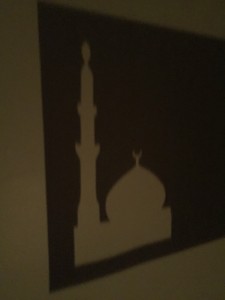Light and Islamic Architecture
Light is featured prominently in Islamic culture, from the Qur’an and hadith to poetry and visual arts. Light is also an important feature of Islamic architecture. Seyyed Hossein Nasr writes, “The great masterpieces of Islamic architecture, such as the Alhambra, the iwans, and the courtyards of so many Persian mosques and the Taj Mahal, are like crystallizations of light, limpid and lucid, illuminating and illuminated, where the space of Islamic architecture is defined by light.”[1] I attempt to show this idea visually. Instead of painting or constructing a model building, I wanted to make as pure an architectural structure as I could. So, using light from a candle and a piece of paper with the silhouette of a mosque, I was able to created a mosque of pure light. A prophetic saying states, “The first being created by God was light.”[2] In my piece I aim to show the creative inspiration of God in Islamic architecture: while God creates light, man creates architecture. My work also references Muslim devotional life. Ali Asani writes, “the straight path mentioned in the Qur’an on which God guides the faithful is often described as the path of peace. Muslims have referred to several verses in this regard, such as 5:16, that says that ‘God guides those with whom He is pleased to the ways of peace, guiding them along the straight path from darkness into light.’”[3] This idea is represented in my work by showing that the Mosque, the ideal place to worship God, is the destination from those coming out of darkness into light. Nasr writes, “Through the ingenious use of light the Islamic architectural spaces are integrated with each other and into a unity which transcends the experience of ordinary and ‘profane’ space.”[4] I highlight the notion of Divine Light manifesting in Islamic architecture, specifically mosque.


[1] Seyyed Hossein Nasr, Islamic Art and Spirituality, (Albany: State University of New York Press, 1987), 50.
[2] Found in Nasr, ibid.
[3] Ali Asani, Infidel of Love, (forthcoming), 54.
[4] Seyyed Hossein Nasr, Islamic Art and Spirituality, (Albany: State University of New York Press, 1987), 55.
Anonymous
March 18, 2016 @ 12:37 pm